Posts Tagged ‘IGA’
Thursday, December 22nd, 2011
“In matters of principle, stand like a rock;
in matters of taste, swim with the current.”
.
~ Thomas Jefferson (1743-1826).
.
.

TASMANIAN FORESTS STATEMENT OF PRINCIPLES TO
LEAD TO AN AGREEMENT
7th October 2010
[Signed by all ten Parties on 14th October 2010]
.
“To resolve the conflict over forests in Tasmania, protect native forests, and develop a strong sustainable timber industry.”
.
.
The Parties to these Principles:
.
- Timber Communities Australia Ltd (TCA)
- The Construction, Forestry, Mining and Energy Union (CFMEU)
- The National Association of Forestry (NAFI)
- The Forest Industries Association of Tasmania (FIAT)
- The Australian Forest Contractor’s Association (AFCA)
- The Tasmanian Forest Contractors Association (TFCA)
- Environment Tasmania Inc. (ET)
- The Wilderness Society (TWS)
- Australian Conservation Foundation (ACF)
- Tasmanian Country Sawmiller’s Foundation (TCSF)
.
Note: Ratio of 7 to 3
.
.
‘Objectives‘ of the Parties
.
‘The parties to the Principles seek from State (Tasmanian) and Federal governments:
.
- Support for an delivery of all principles in full
- Interim support for the development of a plan to deliver the Principles, including:
- Verification (1) of Resource Constraints
- High Conservation Value Boundaries
- Implementation of the Principles through an agreed, fully-funded package and timeline that maximises benefits and reduces negative impacts
- Immediate interim assistance for Tasmanian harvest, haulage and silvicultural contractors
- To determine with industry, a guaranteed sustainable quantity and quality of wood supply within 3 months that is outside of the identified high conservation value forests, for the period of negotiations, in order to provide certainty for the industry, workers and communities.
- A progressive implementation of a moratorium on the logging of high conservation value forests commencing within 30 days – ensuring that priority, (i.e. those in the most advanced stages of planning for harvesting) HCV coupes identified by ENGO’s (2) are the first to be addressed. The full moratorium is to be completed within 3 months. Any necessity for any proposed variation to this due to unavoidable planning constraints has to be independently verified.
- To provide exit assistance for industry where required; and
- Not to accept new entrants into the Tasmanian industry, nor enter into new contractual relationships with the state while the negotiations are underway unless by the mutual agreement of all parties (3).
- Accept that delivery of these Principles will require joint agreement of the parties to timelines and funding.
- To develop an agreed stakeholder-led implementation process with a finalised full agreement within 12 months.
.
– – – – – – – – – – – –
Notes:
.
(1) Draft verification process document under construction.
(2) ENGO’s in this document means those environmental non-government organisations who are parties to this document (i.e. ONLY Environment Tasmania, The Wilderness Society, and the Australian Conservation Foundation)
(3) No party shall be required to accept a Principle which would otherwise apply to it where to do so would cause a breach of an existing contract or statutory obligation.
.
.
The Principles
.
The parties agree to the following:
.
General Wood Supply
Provide a sustainable resource supply profile to industry based on an agreed minimum quantity and quality requirement for industry. This will be underpinned by legislation.
.
Native Forest Wood Supply
Subject to the provisions of the transition, as legislated Native Forest entitlements are handed back, ensure these entitlements will not be allocated nor licensed to new players.
.
HCV Forests
Immediately protect, maintain and enhance High Conservation Value Forests identified by ENGO’s on public land.
.
Transition
Transition the commodity (non specialty) forest industry out of public native forests into suitable plantations through a negotiated plan and timeline.
.
Industry
Create a strong sustainable timber industry including the development of a range of plantation based timber processing facilities including a pulp mill. There will need to be stakeholder consultation and engagement with the proponent, ENGO’s and the community.
.
Specialty Timbers
Provide for ongoing speciality timber supply including Eucalypt for our Tasmanian high value furniture and craft industries through a negotiated plan and timeline.
.
Plantations
Support sustainable and socially acceptable plantations including agreed reforms and new agro-forestry outcomes, including pursuing certification.
.
Private Forests
Encourage and support, but not mandate, private forest owners to: seek assistance for certification; and protect, maintain and enhance high conservation value forests on their properties.
.
Communities Impacted
Support impacted rural and regional communities, workers, contractors and businesses, through a range of economic development, financial assistance, compensation and retraining measures.
.
Community Engagement
Engage and involve the broad Tasmanian community in the development and implementation of a durable solution to the Tasmanian forest conflict.
.
Tourism
Develop Tasmania’s nature based tourism industry in line with these Principles.
.
Planning
Develop a fully funded, independent, scientifically led landscape conservation, restoration and integrated catchment management program, and associated governance and regulatory improvements.
.
Government
Reform and support government agencies, policies and legislation as necessary for the implementation of an agreement associated with these Principles.
.
Climate Change
Seek funding for improving carbon outcomes as a result of delivering these Principles.
.
Biomass
In Tasmania, only permit plantation forest processing and plantation harvesting residues to be used as biomass for Renewable Energy Certificates.
.
Certification
Encourage Forestry Tasmania to firstly obtain Controlled Wood accreditation on delivery of the moratorium, secondly, obtain full FSC certification on resolution of an FSC National Standard and once an agreement based on these Principles has been finalised.
.
Durability
Undertake to ensure all elements of this agreement are fulfilled on a durable basis.
.
Legislation
Require State and Federal legislation to implement agreed outcomes arising from these Principles including appropriate review mechanisms, milestones and sanctions.
.
.
Editor’s Comment:
.
The above Statement of Principles was reproduced manually due to restricted access of the official PDF document as provided on the Tasmanian Premier’s official website. The security lock down denied printing and copying.
But then as Tasmanian Labor Premier Lara Giddings studied Law, perhaps there was a legal reason for her deliberate restriction of the details to the Tasmanian public.
.
This is the Tasmanian Premier’s restricted document:
.
>Tasmanian Forests Statement of Principles (2011)
.
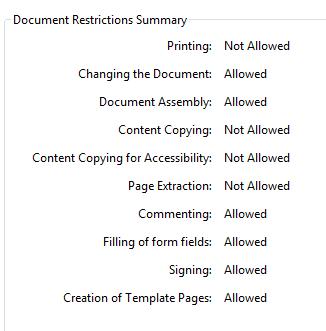
.
Note: Red highlighted text indicates actual shortcomings in the document or process to date.
Note: Green highlighted text indicates particular environmental emphasis.
.
Tags: Community Engagement, Forestry Transition, FSC certification, FSC National Standard, General Wood Supply, HCV Forests, high conservation value forests, IGA, Intergovernmental Agreement, Native Forest Wood Supply, Parties to the Principles, Private Forests, Specialty Timbers, Statement of Principles, Tasmanian Forests Statement of Principles
Posted in 47 Land Reform Initiatives!, Tasmania (AU), Threats from Deforestation, Threats to Wild Tasmania | No Comments »
Add this post to Del.icio.us - Digg
Wednesday, December 21st, 2011
The following article is sourced from ‘Missing peace in forest war’s coupe de grace‘ by Matthew Denholm, The Australian, 20111022,
^http://www.theaustralian.com.au/news/features/missing-peace-in-forest-wars-coupe-de-grace/story-e6frg6z6-122617.
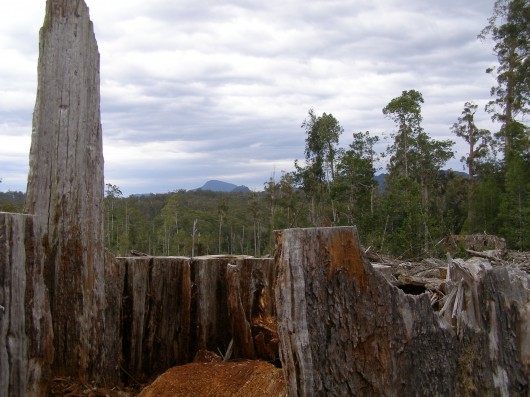 Forestry clearfell of old-growth in Tasmania’s Styx Valley
(Photo by Editor 20110928, free in public domain, click photo to enlarge) Forestry clearfell of old-growth in Tasmania’s Styx Valley
(Photo by Editor 20110928, free in public domain, click photo to enlarge)
.
More than two months (on 7th August 2011) after the landmark deal that promised to bring peace to Tasmania’s forests the protests – and the logging – continue unabated.
Funding for the struggling timber industry under the landmark $276 million Gillard-Giddings deal is starting to trickle out, but as yet not one tree has been saved!
Conservationists concede they may end up with nothing to show for 18 months of torturous negotiations, while many in the industry are sceptical that the promised peace will ever be achieved. The key decisions – on how many and which forests will be saved – are bogged down in difficult detail and alleged recalcitrance. Tasmania’s upper house, meanwhile, is lining up to sink the legislation needed to create the new national parks and reserves.
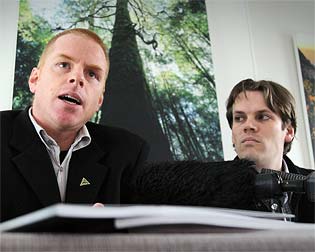 Environment Tasmania’s Phill Pullinger (right) with The Wilderness Society’s Vica Bayley Environment Tasmania’s Phill Pullinger (right) with The Wilderness Society’s Vica Bayley
.
A key conservationist and negotiator, Environment Tasmania director Phill Pullinger, concedes to Inquirer that events could conspire to see money flow to industry without one tree ever being saved.
“To be honest, it is a possibility,” says Pullinger, a Hobart doctor and former young Tasmanian of the year. “It has always been the case that the forest protection couldn’t be permanently delivered until the legislation goes through both houses of the Tasmanian parliament.”
.
That vote is a long way off, probably well into next year. The most immediate hurdle to overcome is a row over whether the state-owned Forestry Tasmania should be allowed to continue logging in 41 coupes (forest areas). All are within 430,000ha of forests set aside for “immediate” interim protection in the Gillard-Giddings deal of August 7, known as the Forests Intergovernmental Agreement or IGA.
Forestry Tasmania insists it needs to log in these coupes, a fraction of the total area, to maintain existing contracts to timber mills. Conservationists argue Forestry Tasmania could and should reschedule logging to less ecologically significant forests. The dispute was being sorted out by an independent rescheduling team appointed by state and federal governments. Inquirer has learned this process has gone badly for conservationists, with only seven of the 41 coupes able to be protected and five already logged. Forestry Tasmania and industry claim there simply is not time to do the rescheduling work – new roads, development of forest practices plans – necessary to shift to new areas quickly enough to meet existing timber contracts.
.
‘It is a fundamental problem that has weakened the (peace) process: you’ve got a government agency that is essentially working against the agreement. And the governments haven’t shown the stomach to pull the agency into line.’’
~ Phill Pullinger, Environment Tasmania, October 2011
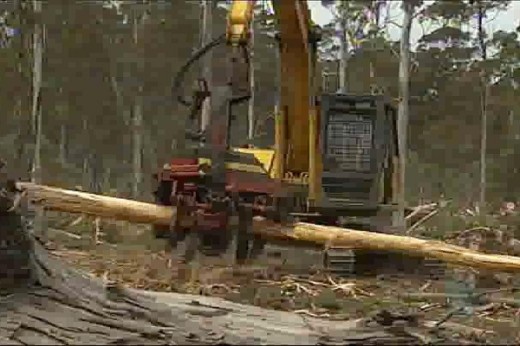
Conservationists claim this should have been done months ago, given that Forestry Tasmania was asked by the state government – its owner – to place a moratorium on logging in these forests in March.
“They (FT) have basically for 12 months now deliberately spun the wheels on that; there could easily have been a moratorium delivered six or nine months ago,” Pullinger says. “It is a fundamental problem that has weakened the (peace) process: you’ve got a government agency that is essentially working against the agreement. And the governments haven’t shown the stomach to pull the agency into line.”
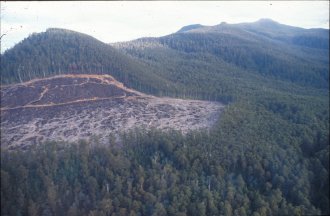
Crew-cutting pristine Tasmanian wilderness
.
This is rare intemperate talk from Pullinger, normally diplomatic and restrained as he tries to keep his constituency in the peace tent and the process on track.
It’s a sign things are not going well. Forestry Tasmania, a government business enterprise that reports to a board and is not necessary bound by ministerial direction, denies it has been dragging the chain. While it is the party with the most to lose – up to 572,000ha of native forest it manages for timber production – corporate relations manager Ken Jeffreys insists it is acting in good faith.
“Some people out there seem to think that FT has some maniacal glint in their eye and go out and harvest forests when it has no market because it has nothing better to do,” Jeffreys complains to Inquirer. “That is so far from common sense it’s hard to respond to.“
He insists Forestry Tasmania is happy to abide by the independent reschedulers’ verdict and points out that it has already rescheduled logging out of some contentious coupes. This fight over a handful of coupes has been holding up plans under the IGA for an overall immediate interim conservation agreement between the state, Forestry Tasmania and Canberra to protect the 430,000ha. Under the IGA, this interim agreement would protect those forests while an independent verification team determines the final size and location of the new permanent reserves.
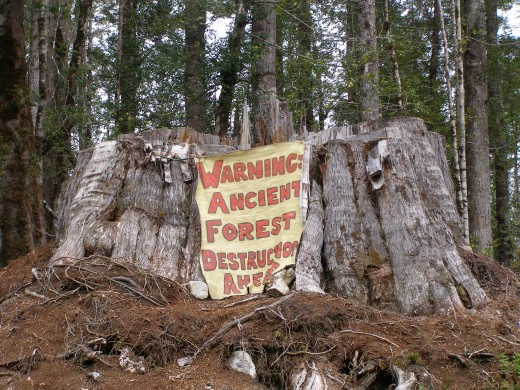 Ancient Myrtle Beech (Nothofagus cunninghamii)
chainsawed in the Upper Florentine Valley, Tasmania
(Photo by Editor 20110928, free in public domain, click photo to enlarge) Ancient Myrtle Beech (Nothofagus cunninghamii)
chainsawed in the Upper Florentine Valley, Tasmania
(Photo by Editor 20110928, free in public domain, click photo to enlarge)
.
IGA Independent Verification Team
.
The independent team, overseen by academic Jonathan West, will decide how much forest, of a larger 572,000ha nominated by green groups, is worthy of protection. West’s team will also test industry claims about how much timber it requires to meet existing contracts. Then it must decide how much forest can be protected while providing this resource. The job, which unrealistically is due to be completed by December 31, is the “forest wars” equivalent of deciding where exactly the boundaries of a Palestinian state should be drawn.
Conservation groups believe that most – if not all – of the 572,000ha can be protected, once a developing plantation resource is factored in.
.
Forestry Tasmania’s position
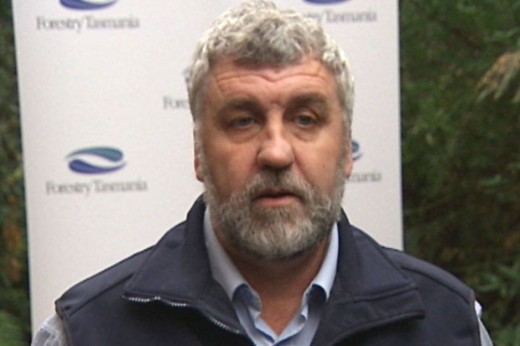
Forestry Tasmania chief, Bob Gordon
– what IGA? It’s logging business as usual to fill ‘orders’.
.
Forestry Tasmania stands by its modelling suggesting that no more than 300,000ha can be protected if it is to deliver on current timber contracts. Some in the industry believe only 250,000ha can be saved from the chainsaws. Neither of the industry figures is unlikely to be enough for conservationists, but may well be too much for Tasmania’s independent-dominated upper house. Several recent votes in the Legislative Council suggest it is opposed to the IGA and to more forest “lock-ups”. Its refusal to pass the reserves would leave conservationists relying on a federal-state conservation agreement to protect those forests.
While such an agreement would ban logging, it is legally uncertain if Forestry Tasmania could ignore this on the basis that it conflicts with its legislative or contractual obligations.
Jeffreys insists Forestry Tasmania would abide by any final agreement, subject to being able to meet those commitments – a big out if Forestry Tasmania decided to dig in for a battle.
.
Tony Burke’s position:
.
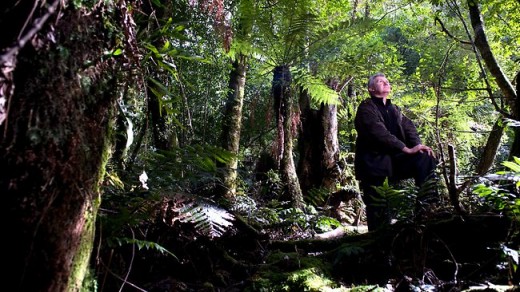 Federal Environment Minister Tony Burke
in Tasmania’s Wielangta forest, March 2011
(Photo by Matthew Newton, Source: The Australian ) Federal Environment Minister Tony Burke
in Tasmania’s Wielangta forest, March 2011
(Photo by Matthew Newton, Source: The Australian )
.
Despite the difficulties, federal Environment Minister Tony Burke remains confident he can pull off the kind of final “win-win” forest peace deal that has eluded so many of his predecessors. He tells Inquirer the alternative is a kind of mutually assured destruction, whereby the forests continue to fall as fast as the jobs.
The number of jobs in Tasmanian forestry has halved since 2008 from 6960 to 3460, due mainly to Japanese paper-makers boycotting woodchips sourced from native forests, Gunns exiting the industry in favour of a plantation-based pulp mill and as a result of the high Australian dollar.
“If you let the markets sort this one out without a co-ordinated strategy from state and federal government … then you end up with a terrible outcome for the Tassie economy … diabolical,” Burke says.
Initially as Forests minister and more recently as Environment Minister, Burke has been involved in the process from the beginning. The first in federal cabinet to twig to the potential to assist industry while securing a historic conservation outcome, he has repeatedly slipped quietly into Tasmania to do his own field work.
The former staffer to Graham Richardson has camped with greenies amid the giant eucalypts of the Styx Valley and toured sawmills and production forests. When the process has looked as if it were imploding, he has intervened with all sides to keep it on track. Inspired to join the ALP by landmark conservation battles such as the Daintree and Kakadu, Burke constantly stresses his desire to also secure a good outcome for jobs and industry.
He believes the (Tasmanian) Legislative Council will take a different view to new reserves when details are developed for a $120m federal regional development fund promised under the IGA. That money, to revitalise timber communities and diversify the Tasmanian economy, is contingent upon state parliament passing the new reserves legislation. No reserves; no $120m.
Burke, himself a former state upper house MP (in NSW), believes this cash for regions will ultimately win over the key 12 independent MLCs.
“Those MPs will have to look in the eyes of a whole lot of their constituents who are out of work and justify their actions,” he says. “I just don’t believe when it comes to it they’ll vote this down. This is the first time we have tried to deal with this issue with an independent process rather than a political fix. The irony this time is: can we stop politics from wrecking it, not from fixing it?”
He warns both sides will need to accept the outcome of the independent verification process. “They are honour-bound to accept the process – they created it,” he says.
This suggests Canberra will not be afraid to impose the verdict of the independent verification team if the two sides cannot embrace it – or at least an agreed variation of it. Such action may well see either side – timber or conservation – walk away.
Certainly, Pullinger won’t promise to accept the outcome if it is not embraced by both sides.
“If the independent verification group comes down and says … we are going to protect just a fraction of these forests … then – expert group or not – I don’t think anyone believes that is going to be able to deliver a lasting agreement.”
.
Editor:
The IGA deal is a deal is a promise. Why are Gillard and Giddings allowing Forestry Tasmania to renege on the deal by continuing to log these now protected native forests in Tasmania’s Styx Valley and southern forests. Why are Gillard and Giddings breaking their promise to Tasmanians?
IGA interim reserves are IGA interim reserves? The IGA offers millions in contractual compensation. So take the compensation Bob Gordon! You can’t have your compensation and interim reserves too!
Leave the bloody old growth alone!
 Prime Minister Julia Gillard, 2011
– do I really have to honour that forest deal?
(Photo: The Examiner) Prime Minister Julia Gillard, 2011
– do I really have to honour that forest deal?
(Photo: The Examiner)
.
Evidence of new logging despite Tasmanian Forests Agreement
.
[Source: ‘ Evidence of new logging despite Tasmanian Forests Intergovernmental Agreement requires urgent government action‘, by the Australian Conservation Foundation, 20110922, ^ http://www.thegreenpages.com.au/news/evidence-of-new-logging-despite-tasmanian-forests-intergovernmental-agreement-requires-urgent-government-action/]
.
Environment Tasmania, the Wilderness Society and the Australian Conservation Foundation have released a report assessing the status of logging in important native forests and photographs that show new logging activity in forest reserves prescribed by the Tasmanian Forests Intergovernmental Agreement (IGA).
“The settlement and retirement of Gunns’ native forest timber quotas has halved the demand for native forest timber from Forestry Tasmania, so there is no need or justification for logging within the forest reserve areas,” said Dr Phill Pullinger of Environment Tasmania.
“Wood supply for remaining sawmills can be provided from outside of the important native forests identified for protection,” Dr Pullinger said.
“Aerial photographs taken in late August and last week show Forestry Tasmania continues to log inside the 430,000 hectares of unique and important forests identified for immediate protection in the IGA,” said Vica Bayley of the Wilderness Society.
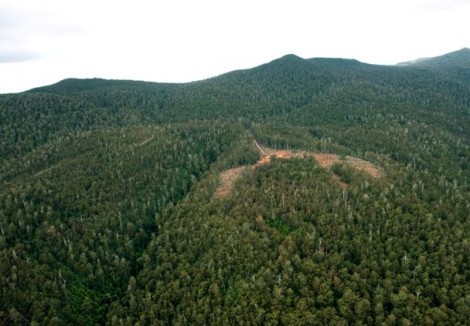
“In fact, our report and the new photos show Forestry Tasmania has not rescheduled logging outside this area and has even commenced logging new coupes since the IGA was signed.
“While we are encouraged to see progress on key components of the intergovernmental agreement — including the retirement of Gunns’ wood quota, funding for timber workers and contractors and the independent verification group — we have seen no progress on halting logging inside the nominated forest reserve areas,” Mr Bayley said.
“Environment groups again call on the state government to honour the agreement it has signed by directing Forestry Tasmania to declare the nominated forests as informal reserves and immediately appointing an independent expert to undertake the rescheduling,” said Denise Boyd of the Australian Conservation Foundation.
The report released today is part of environment group signatories’ ongoing commitment to implementing the IGA and will provide governments with verified, accurate information to help achieve the forest protection outcomes of the IGA. The state government must now ensure delivery of the critical plank of the IGA – forest protection.
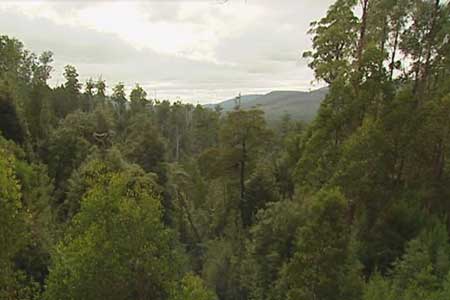
“We have seen no progress on halting logging inside the nominated forest reserve areas.”
~ Vica Bayley, The Wilderness Society
.
Forest protest continues in Mount Mueller Forest, Styx Valley (Tree Sit, Day 7)
.
Check out The ObserverTree protest website:
^http://observertree.org/
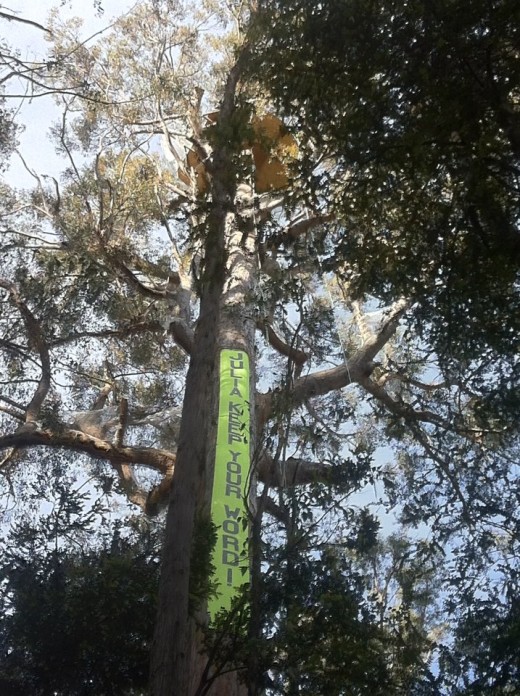
.
Tags: breaking promise, clearfell, Crew-cutting pristine Tasmanian wilderness, Environment Tasmania, Forestry Tasmania, IGA, interim reserves, Julia Gillard, Lara Giddings, Myrtle Beech, Nothofagus cunninghamii, Prime Minister Julia Gillard, Styx Forest, Styx Valley, Tasmania, Tasmanian Forests Intergovernmental Agreement, The ObserverTree, Tony Burke, Upper Florentine Valley
Posted in Tasmania (AU), Threats from Deforestation, Threats to Wild Tasmania | No Comments »
Add this post to Del.icio.us - Digg
Wednesday, November 23rd, 2011
‘The axe had never sounded’…
.
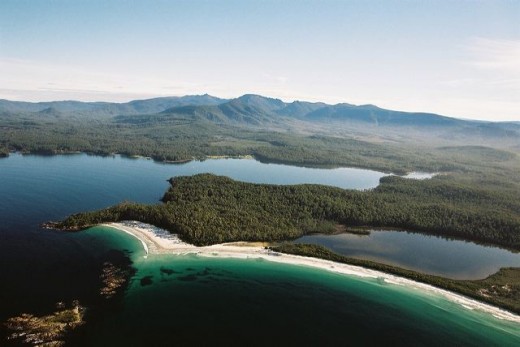 Unprotected ancient native forests around Tasmania’s Recherche Bay Unprotected ancient native forests around Tasmania’s Recherche Bay
(Photo by Bob Brown)
.
Despite Tasmania’s Inter-governmental Agreement (IGA) on 7th August 2011 assuring immediate logging moratorium of native forests in agreed reserves, Forestry Tasmania continues to eco-rape and pillage protected native forests in defiance of this agreement.
IGA Clause 25 states:
‘The State will immediately place the 430,000 hectares of native forest identified in Attachment A (other than any areas that are not State forest), from the 572,000 hectares nominated by ENGOs through the Statement of Principles process, into Informal Reserves. The boundaries of this 430,000 hectares were verified through an independent verification process.’
The southern forests around Recherche Bay were agreed to be included into the Informal Reserves through the Independent Verification Process.
So by embarking on new logging in these Informal Reserves, clearly Forestry Tasmania is in breach of the IGA and operating out of the control of the Tasmanian Government. Forestry Tasmania is logging Tasmania like there’s no tomorrow, because it knows there it has no tomorrow. The business is seriously loss-making. It’s continuing unfettered destruction of Tasmanian native forests is akin to the calculated genocide of Sri Lankan Tamils in May 2009 by the Sinhalese Sri Lankan dictator Mahinda Rajapaksa. Forestry Tasmania’s manic mindset has it logging and woodchipping native forests until they’re all decimated. And Lala’s Labor Government doesn’t have the gumption to enforce the moratorium on its own renegade department.
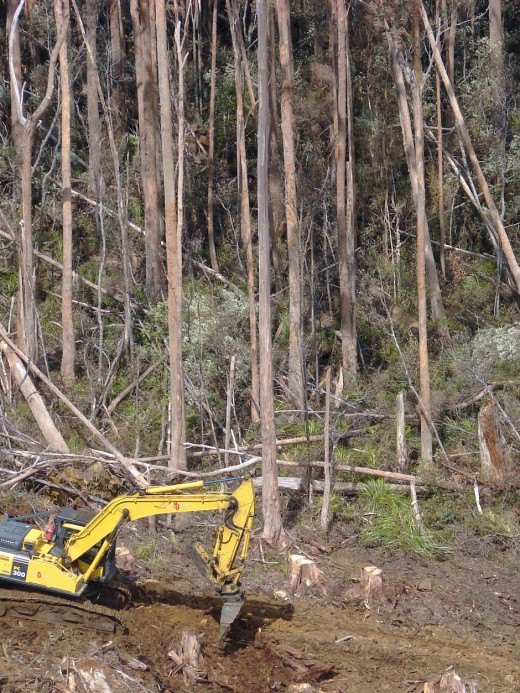 Forestry Tasmania getting stuck into native forests near Tasmania’s Recherche Bay, May 2011
[Source: ABC, ‘Bid for forest peace funding’, 20110519, ^http://www.abc.net.au/news/stories/2011/05/18/3220585.htm?site=hobart] Forestry Tasmania getting stuck into native forests near Tasmania’s Recherche Bay, May 2011
[Source: ABC, ‘Bid for forest peace funding’, 20110519, ^http://www.abc.net.au/news/stories/2011/05/18/3220585.htm?site=hobart]
.
Not only is this organisation out of control, it has no market for its woodchip product. The logs are trucked to woodchipping mills only to be stockpiled with nowhere to go. With no income, it is a business heading for collapse. Unpaid wages will likely remain that way, when the doors are finally closed up. Meanwhile Tasmania’s remaining old growth forests are being logged and the ancient vital ecology decimated.
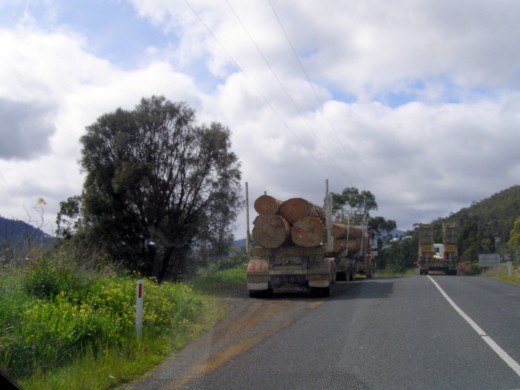 Loaded logging truck (New Norfolk, 20110929)
(Photo by editor, free in public domain) Loaded logging truck (New Norfolk, 20110929)
(Photo by editor, free in public domain)
.
Conservationists are this morning conducting a protest in a logging area in the far south of Tasmania, where world heritage value forests are being clearfelled.
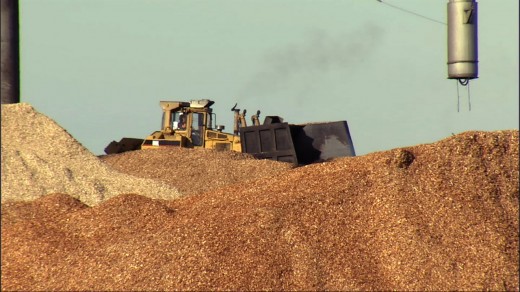
.
Huon Valley Environment Centre’s Jenny Weber says:
‘Tasmania’s world heritage value forests continue to be logged despite yesterday’s controversial announcement that woodchips shipments have been postponed by Tasmania’s only export woodchipping company, Artec (Artec Pty Ltd, Lilydale).’
‘Ta Ann is driving logging in contentious forests, and woodchip logs are leaving these same forests regardless of a viable market for the timber. The Tasmanian taxpayers are subsidising a logging industry that is economically unviable and environmentally unsustainable.’
‘This morning at Catamaran, in threatened forest behind Recherche Bay, a conservationist is in a tree sit, and thirteen people are halting logging. Huon Valley Environment Centre is repeating it’s calls for the immediate end to logging in this forest that borders the Tasmanian Wilderness World Heritage Area, (TWWHA).’
.
Logging in this area, identified by Forestry Tasmania as CM004C, commenced after the Prime Minister Julia Gillard and Premier Lara Giddings announced the Inter-governmental Agreement on 7th August 2011 would provide ‘immediate protection in informal reserves’ for forests such as these.
 Tasmanian Premier Lara Giddings and Australian Prime Minister Julia Gillard
signing the Tasmanian Forests Agreement, 7th August 2011 Tasmanian Premier Lara Giddings and Australian Prime Minister Julia Gillard
signing the Tasmanian Forests Agreement, 7th August 2011
.
Forestry Tasmania Coupe ‘CM004C’ is located within the 572 000ha of identified forests for legislated protection. Last week conservationists participated in a protest in the coupe, and it was revealed that the area is being clearfelled for Ta Ann, export peeler logs and woodchip logs.
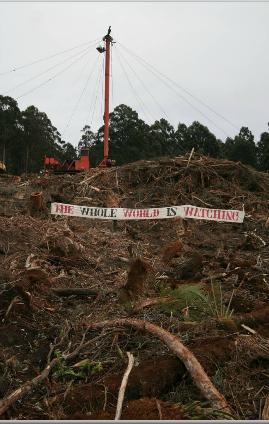 Forestry Tasmania’s cable logging of The Weld Forest, 2009
Tasmanian Southern Forests
(Huon Valley Environment Centre)
(click image to link to slide show) Forestry Tasmania’s cable logging of The Weld Forest, 2009
Tasmanian Southern Forests
(Huon Valley Environment Centre)
(click image to link to slide show)
IGA Clause 26 states:
.
‘The State will ensure that, until the further independent verification process required under Clause 20 is completed, wood supply required under Clause 17 will be sourced from outside the 572,000 hectares of ENGO-nominated High Conservation
Value forest area unless the remaining State Forest area is insufficient to meet the contractually specified quality and quantity of wood supply. Where this is the case, the Tasmanian Government will ensure that wood supplies are sourced outside the 430,000 hectares placed in Informal Reserves. The Tasmanian Government will ensure that the 430,000 hectares of State Forest identified in Attachment A is not accessed’
.
Analysis:
-
There are copious hundreds of hectares of Tasmanian forest area available outside the 572, 000 hectares of ENGO-nominated High Conservation Value forest area.
-
The Lala Labor Government by not ensuring wood supply is sourced outside the 430,000 ha in Informal Reserves is not accessed, and thus in prima facie breach of the IGA. Lala Labor is deliberately and mischievously exercising selective deafness by not listening to ENGO accusations of the breach of the IGA terms. Labor as head wolf of the chicken pen, turning a blind eye to its fellow wolves while they help themselves to the plunder.
-
The Gillard Labor Government is in breach of IGA Clause 27, by failing to act on this trigger ‘to appoint independent expert specifically to review scheduling and other relevant data and attempt to reschedule harvesting activities so as to meet the requirements of contracts and maintain the interim protection of the 430,000 hectares’. The option of log anyway is not an option. The prescribed option under IGA Clause 27, is that the Commonwealth will instead compensate the contract holder for the value of lost profits and unavoidable costs.
-
Both Governments, by sitting on their hands as forests in the Informal Reserves are logged, are in breach of the spirit of the Agreement.
.
.
2009: ‘Woodchip stockpile in Tasmania a ‘health risk’
[Source: Matthew Denholm, Tasmania correspondent, The Australian, 20091014, ^http://www.theaustralian.com.au/news/woodchip-stockpile-in-tasmania-a-health-risk/story-e6frg6ox-1225786465432]
.
The woodchip stockpile in Burnie could pose a “significant health risk”, according to an expert opinion being assessed by health authorities. Tasmanian Director of Public Health Roscoe Taylor said the advice that the stockpile would at times contain Legionella bacteria is being examined.
“I have actually asked someone to have a look at it — we’ll be taking a look at it,” Dr Taylor said.The advice from Legionella expert Trevor Steele concludes the bottom layer of the stockpile on Burnie’s wharf would “undoubtedly” contain Legionella at times. Dr Steele warned the bacteria’s dispersal via dust could pose a significant health risk to townsfolk near the wharf and to workers at the port.
“It (the bottom layer) will at times undoubtedly contain Legionella and these could multiply there given the right conditions,” he said.
“This layer would also act as a source to contaminate newly arrived woodchips, setting the stage for a new cycle of Legionella growth.
“Dispersal of dust … containing these organisms could pose a significant health risk to susceptible persons working in, or residing in, adjacent residential or business districts, as well as to susceptible workers on the Gunns site and in the port area.”
Dr Steele was commissioned to provide the advice by Royal Hobart Hospital physician Frank Nicklason. Last week, Dr Nicklason apologised to timber company Gunns for his 2004 statement that the woodchip pile “almost certainly” had Legionella present that could blow across Burnie. However, he said his concerns about the potential for public health risks from the pile — initially sparked by several Legionella cases in Burnie — remained.
Dr Nicklason said he accepted that Gunns’ sampling in 2002 had not found Legionella in the pile. However, he said Dr Steele’s findings, from July this year, contributed to his concern and warranted further investigation.
Gunns’ own advice, conducted independently in 2002 and released under Freedom of Information, found that the available evidence “suggests strongly” that the bottom layer is “not a reservoir for Legionella”.
However, Dr Steele, formerly director of clinical microbiology at the Institute of Medical and Veterinary Science in Adelaide, disagreed.
“To claim that the sacrificial layer did not contain Legionella on the basis of two tests of small samples is misleading,” he says.
He agreed the bottom layer, because it was relatively undisturbed, was unlikely to pose much risk to the community, but that this did not mean there was no risk, since Legionella there could contaminate new woodchips.
When asked whether Gunns stood by its own findings, a spokesman said: “We don’t have to: Dr Nicklason has stood by it.
“At the time Dr Nicklason gave this apology he was in possession of the Steele report. His attempt to retract his apology by reference to this report is hypocritical, disingenuous and beggars belief.”
Dr Nicklason said his “carefully worded” apology — made as part of settlement of defamation proceedings — merely acknowledged that Legionella had not been found in samples taken by Gunns, and that its report had concluded there was “no available data” to implicate woodchips as a microbial health risk.
There are few detailed studies of Legionella in woodchip piles, although Dr Steele has found the bacteria present in all forms of composting and degrading wood products, including woodchips.
On the basis of his work, Dr Steele believes that conditions in woodchip stockpiles are ideal for Legionella and other micro-organisms that require moisture and warmth.
Legionella is thought to spread by people inhaling the bacteria contained in tiny water droplets, known as aerosols, or in dust.
Over the years, there have been complaints about dust and debris blowing from the stockpile to the Burnie CBD, adjacent to the port.
These have been focused on days of easterly winds, which occur about 20per cent of the time, and when woodchips were being loaded on to ships.
The 2002 Gunns report, conducted by Adelaide environmental health expert Richard Bentham, pointed out that survival of Legionella in aerosols was “highly dependent upon ambient weather conditions”.
For this reason, Dr Bentham concluded the health risks from the Burnie pile were “most probably confined to employees or contractors working on the site” and that transmission beyond the port area was “unlikely”.
However, Dr Steele says Legionella “could survive well in dust travelling long distances, even in adverse climatic conditions”. He cites instances of up to 20km.
.
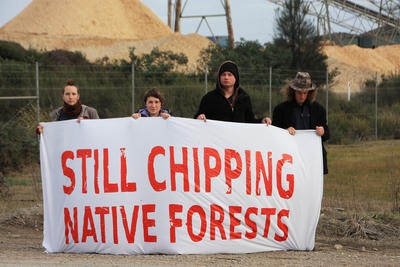
.
.
Recherche Bay – a brief background
.French explorer D’Entrecasteaux led his ships to grateful shelter in Recherche Bay, southwest of Hobart, in 1792 and 1793, recording “ancient forests, in which the sound of an axe had never been heard”. Barely 200 years later, the forest of Recherche Bay is being threatened by the sound, not merely of axes, but of bulldozers and chainsaws.In spite of public protest and National Heritage listing, the green light to log the area has been given.
- 24/1/06 Entrepreneur/adventurer Dick Smith offers $100,000 towards the purchase of Recherche Bay plus a $1.9 million no-interest loan to be paid back within 12 months.
- 5/11/05 Over 5000 people rally in Hobart for the protection of Recherche Bay. Bob Brown launches a bid to purchase the peninsula, asking people to pledge units of $1,000 to raise the money. Bob pledges $5,000.
- 6/10/05 Senator Ian Campbell announces Recherche Bay will be placed on the National Heritage list but says logging will still go ahead.
- 19/8/05 Launch of Bob Brown’s photographic exhibition and book, Tasmania’s Recherche Bay
- 27/4/05 Actor David Wenham and director Robert Connolly fly over Recherche Bay and visit the tall trees in the Styx Valley, stating their support for conservation.
- 20/4/05 Tasmanian Greens leader Peg Putt calls on French scientists to help save Recherche Bay
- 17/4/05 1000 people rally on site to protect Recherche Bay
- Nov, 03 Tasmanian Heritage Council recommends the protection of the north east peninsula for its cultural significance.
[Source: ^http://www.leatherwoodonline.com/wild/2006/recherche_bay/index.htm]
.
.
1993: ‘Campaign over Recherche Bay scores win’
[Source: Bob Elliston, Hobart, Green Left Weekly, 19931117, ^http://www.greenleft.org.au/node/34677]A five-year campaign to save part of historic Recherche Bay, in south-east Tasmania, has been won, with all parties involved having achieved a satisfactory resolution. The agreement was announced on February 8 by Labor Premier Paul Lennon.Thanks mostly to the support of well-known philanthropist Dick Smith, the tireless negotiations of Greens Senator Bob Brown and the decency of owners David and Robert Vernon, 142 hectares of forest will now be purchased by the Tasmanian Land Conservancy for $2.21 million.Recherche Bay had been under the threat of logging by Gunns Ltd since a contract with the owners was signed in 1998. The bay became home to a French expedition to observe the Earth’s magnetic field in 1792 and 1793. Had logging gone ahead, today’s very destructive logging techniques would have destroyed any chance for useful archaeology of the site to be conducted.Under the deal, Dick Smith will lend the Conservancy group $2 million, $100,000 of which is a personal donation. The state government, which initially supported the Vernon brothers’ decision to have the area logged, has now agreed to assist with $210,000 towards the cost of the land. In addition, the government will waive the $80,000 it would have collected in stamp duty. donations exceeding $238,000 have already been pledged.Although the small forest will not be harvested, no jobs will be lost. More jobs are likely to be generated in services supporting the local community and scientific interest.
However, the deal is not without its critics. Terry Edwards, CEO of the Forestry Industries Association, is distressed that the forest will continue to grow, rather than be turned into cash for Gunns. Newly appointed federal forests minister and Tasmanian senator Eric Abetz has also criticised the agreement, describing it as “a grubby deal”. According to Abetz, the area “has no heritage value”.
.
.
Further Reading:
.
[1] The Last Stand, ^http://www.thelaststand.org.au/, Media Release 20111116:
‘The HVEC and Code Green have taken direct action on Tassie’s forest floor this morning to highlight ongoing logging in high conservation value forests that were supposed to be protected under the Inter-governmental Agreement. Campaigners are currently taking simultaneous action in two logging coupes in the north and south of the island – RS117C on Roses Tier, north of Ben Lomond, and in the Catamaran area, where forests are being logged behind Recherche Bay.
“This is an area that should have been given immediate protection on March 15 this year. Instead we are still seeing machines clearing what has been identified by both the State and Federal Governments as being of high conservation value.” Said Jared Irwin, spokesperson for Code Green.
“The lost values of these forests that are bordering the Tasmanian Wilderness World Heritage Area is such a tragedy, when the logging commenced after the State and Federal Governments announced they would be protected in August 2011,” Said Jenny Weber, Huon Valley Environment Centre’s spokesperson.’
.
[2] ^http://www.nativeforest.net/
.
[3] Tasmanian Intergovernmental Forest Agreement 2011, ^http://australia.gov.au/content/tasmanian-forests-agreement
.
[4] ‘The Axe Had Never Sounded: place, people and heritage of Recherche Bay, Tasmania’, by John Mulvaney, published by ANU E Press and Aboriginal History Incorporated, ANU E Press,
^http://epress.anu.edu.au/aborig_history/axe/html/ch13.html
.
‘A thriving sawmilling industry existed at two centres around the bay by 1900. The steam-driven mill continued at Waterhole Cove until 1868. Then the industry faltered until 1884, when large sawmills were established by the Catamaran River and at Leprena on the western side of the northern bay. By 1900 the population living there exceeded 100 at each centre. It was around the turn of the century that coal mining also offered employment, and an active industrial period followed for a few years. The seams of coal proved limited or uneconomic. As trees were felled, their distance from the sawmill increased. This required timber rail tramways establishing a network radiating out from an area and moved on when that area was harvested. The same applied to transporting coal.
By 1939 a complex network radiated from harbour-based centres at Catamaran, Leprena and Cockle Creek. Traces of these lines survive today in regrowth forests.[1] One moss-covered segment runs by the shore on the north-eastern peninsula in the area of the French activities in 1792.
The timber industry is necessarily situated in forests, so bushfires prove a recurring hazard. The Catamaran mill was destroyed in a 1914 bushfire, coinciding with the abandonment of the coal mine there. The spasmodic and transitory nature of frontier employment was again demonstrated at Recherche Bay when the community of around 100 people, supporting a school and a store, faced sudden unemployment. Today the media feature factory closures and speculate about the future employment of the urban employees. The history of much of rural Australia also has been a boom and bust story of employment, as rural industries prosper then fold. Recherche Bay is a classic example. On a smaller scale than urban plant closures, the impact upon the families dependant upon a timber mill or colliery was no less drastic.’
[Chapter 13. Good and Bad Times]
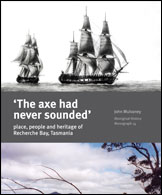
|
The State will ensure that, until the further independent verification process required under Clause 20 is completed, wood supply required under Clause 17 will be sourced from outside the 572,000 hectares of ENGO-nominated High Conservation Value forest area unless the remaining State Forest area is insufficient to meet the contractually specified quality and quantity of wood supply. Where this is the case, the Tasmanian Government will ensure that wood supplies are sourced outside the 430,000 hectares placed in Informal Reserves. The Tasmanian Government will ensure that the 430,000 hectares of State Forest identified in Attachment A is not accessed. Where harvesting work has already begun in coupes within the nominated 430,000 hectares, rescheduling will occur as soon as practical and a list of coupes that will be harvested will be agreed by the Governments and the signatories, advised by the Independent Verification Group, within two weeks of the signing of this agreement. If sourcing of wood supply from within the 572,000 hectares is considered to be necessary under any circumstances, the Governments will immediately consult with the Reference Group of Signatories and the Independent Verification Group in order to inform them of the basis for sourcing wood supply in those areas, and with the intention of providing this supply in a way that minimises impacts on conservation values.
|
|
During the independent verification process, in the event that Forestry Tasmania reports that it cannot meet contractual requirements from production resources outside the nominated 430,000 hectares, the Governments will undertake the following steps. First, an independent expert will be jointly appointed by the Governments to review scheduling and other relevant data and attempt to reschedule harvesting activities so as to meet the requirements of contracts and maintain the interim protection of the 430,000 hectares. In the event that the independent expert concludes that it is impossible to achieve this through rescheduling on a reasonable commercial basis or through sourcing alternative supplies, the Commonwealth will compensate the contract holder for the value of lost profits and unavoidable costs. Any such costs will be met, in the first instance, from within the $7 million payment in financial year 2011-12 referred to in Clause 35.
|
Tags: Catamaran, Clause 25, Forestry Tasmania, IGA, illegal logging, logging moratorium, Recherche Bay, Roses Tier, Ta Ann Group, Tasmanian Forests Intergovernmental Agreement, Tasmanian Wilderness World Heritage Area, the axe had never sounded, Weld Forest, woodchip horders, woodchip stockpile health risk
Posted in Tasmania (AU), Threats from Deforestation, Threats to Wild Tasmania | No Comments »
Add this post to Del.icio.us - Digg
|
|













 Unprotected ancient native forests around Tasmania’s Recherche Bay
Unprotected ancient native forests around Tasmania’s Recherche Bay















